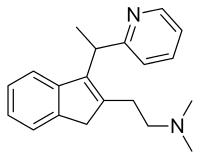Dimetindene
Dimetindene is an antihistamine/anticholinergic. It is a first generation[1] selective H1 antagonist.[2] Dimetindene is an atypical first generation H1 antagonist as it only minimally[3] passes across the blood-brain barrier.
 | |
| Clinical data | |
|---|---|
| Trade names | Fenistil |
| AHFS/Drugs.com | International Drug Names |
| Routes of administration | Oral, topical |
| ATC code | |
| Legal status | |
| Legal status |
|
| Identifiers | |
IUPAC name
| |
| CAS Number | |
| PubChem CID | |
| DrugBank | |
| ChemSpider | |
| UNII | |
| KEGG | |
| ChEMBL | |
| CompTox Dashboard (EPA) | |
| ECHA InfoCard | 100.024.622 |
| Chemical and physical data | |
| Formula | C20H24N2 |
| Molar mass | 292.418 g/mol g·mol−1 |
| 3D model (JSmol) | |
| Chirality | Racemic mixture |
SMILES
| |
InChI
| |
| (verify) | |
Dimetindene is also an M2 receptor antagonist.[4]
It was patented in 1958 and came into medical use in 1960.[5]
Medical use
Dimetindene is used orally and topically as an antipruritic.[6] It is used topically to treat skin irritations, such as insect bites. Dimetindene is also administered orally to treat allergies, such as hay fever.
It is commonly formulated as its maleic acid salt, dimethindene maleate.
Names
It is sold under the brand name Fenistil among others.
References
- Simon, F. Estelle R.; Simons, Keith J. (2008). "H1 Antihistamines: Current Status and Future Directions". World Allergy Organization Journal. 1 (9). doi:10.1186/1939-4551-1-9-145. PMC 3651039.
- "Dimetindene". Drugs.com.
- "WikiGenes - Collaborative Publishing". WikiGenes - Collaborative Publishing. Archived from the original on 2018-09-13. Retrieved 2019-03-13.
- Matsumoto, Yoshihiro; Miyazato, Minoru; Furuta, Akira; Torimoto, Kazumasa; Hirao, Yoshihiko; Chancellor, Michael B.; Yoshimura, Naoki (2010). "Differential Roles of M2 and M3 Muscarinic Receptor Subtypes in Modulation of Bladder Afferent Activity in Rats". Urology. 75 (4): 862–867. doi:10.1016/j.urology.2009.12.013. PMC 2871158. PMID 20156651.
- Fischer, Jnos; Ganellin, C. Robin (2006). Analogue-based Drug Discovery. John Wiley & Sons. p. 547. ISBN 9783527607495.
- Wexler, L. (1962). "A Clinical Evaluation of Dimethindene". Current Therapeutic Research, Clinical and Experimental. 4: 306–9. PMID 14006402.
This article is issued from
Wikipedia.
The text is licensed under Creative
Commons - Attribution - Sharealike.
Additional terms may apply for the media files.